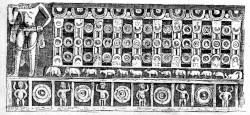Kanheri Caves
Useful Information


| Location: |
About 40 km north of Mumbai (Bombay), in the Krishnagiri Upavan National Park.
(19.207008, 72.904167) |
| Open: |
All year Tue-Sun 7:30-18:30. Train ride: All year Tue-Sun 9-12:30, 13:30-17:30. [2022] |
| Fee: |
Train ride:
Adults INR 55, Children (5-12) INR 21. [2022] |
| Classification: |
 Cave Church Cave Church
|
| Light: | bring torch |
| Dimension: | |
| Guided tours: | self guided |
| Photography: | allowed |
| Accessibility: | |
| Bibliography: |
James M. Campbell (1896):
Gazetteer of the Bombay Presidency,
.
James Fergusson, James Burgess (1880): The Cave Temples Of India., LONDON: W. H. ALLEN & Co., Waterloo Place ; TRUBNER & Co., Ludgate Hill ; E. STANFORD, Charing Cross; and W. GRIGGS, Hanover Street, Peckham. 1880. online |
| Address: |
Sanjay Gandhi National Park, Kanheri Caves, Mumbai, Maharashtra 400101, Tel: +91-1800-22-9930.
Nature Information Center, Tel: +91-22-28868686. E-mail: |
| As far as we know this information was accurate when it was published (see years in brackets), but may have changed since then. Please check rates and details directly with the companies in question if you need more recent info. |
|
History
| 1st century BC | oldest caves excavated. |
| 1st century | most caves excavated. |
| 9th century | last caves excavated. |
| 1839 | rediscovered by Dr. James Bird. |
Description


Protected by a dense jungle, these are a series of 109 Buddhist caves or monasteries in a rocky ravine where the monks practised their austerities. Unlike the artistic extravagance of Elephanta, they are spartan and bare. Each tiny cell cut into the flank of a hill, is fitted with a stone plinth that evidently served as a bed. Cave No 3 or the Great Chaitya Cave, is the most important, it is also a meeting hall, 38 m x 14 m x 14 m supported by huge stone pillars that contains the dagoba, a kind of Buddhist shrine. If you pick your way up the hill you will find channels and cisterns that are remnants of an ancient water system that channelled rainwater into huge urns. In fact, Kanheri probably provides the only clue to the rise and fall of Buddhism in Western India.
Text by Tony Oldham (2003). With kind permission.
The Kanheri Caves are a 2000 year old Buddhist cave complex, the name Kanheri is derived from the Sanskrit word Krishnagiri, which literally means black mountain. The site is a park with roads, so you can drive from parking lot to parking lot, but there are also trails. You must leave the park at 18:30, so keep the way back in mind. As it is a park a lot of things are prohibited, like speeding, parking at the road, alcohol, smoking, pets, plastic bags, and fire. The park offers a tourist train ride on a narrow gauge railway which takes about 25 minutes.
The Island of Salsette, or ShatsMslithi, at the head of the Bombay harbour, is peculiarly rich in Rock-Temples, there being works of this kind at Kanheri, Marol, Magathana, Mandapeswar, and Jogeswari.
The most extensive series is the group of Buddhist caves at Kanheri, a few miles from Thana, in which are about 109 separate caves, mostly small, however, and architecturally unimportant.
James Fergusson, James Burgess (1880):
The Cave Temples Of India.,
LONDON: W. H. ALLEN & Co., Waterloo Place ; TRUBNER & Co., Ludgate Hill ; E. STANFORD, Charing Cross; and W. GRIGGS, Hanover Street, Peckham. 1880.
online




 Search DuckDuckGo for "Kanheri Caves"
Search DuckDuckGo for "Kanheri Caves" Google Earth Placemark
Google Earth Placemark Kanheri Caves, official website (visited: 18-SEP-2022)
Kanheri Caves, official website (visited: 18-SEP-2022) Index
Index Topics
Topics Hierarchical
Hierarchical Countries
Countries Maps
Maps